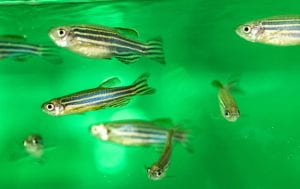I. Introduction/Purpose
 The goal of environmental enrichment for zebrafish and medaka is to maximize species-specific positive behavior and enhance the animals’ well-being.
The goal of environmental enrichment for zebrafish and medaka is to maximize species-specific positive behavior and enhance the animals’ well-being.
The Guide for the Care and Use of Laboratory Animals states that for aquatic animals, “Acceptable primary enclosures allow for the normal physiologic and behavioral needs of the animals, including … normal movement and postural adjustments … allow for conspecific social interactions…etc. ” Additionally, the Guide states that “Environmental enrichment strategies for many aquatic species are not well established…When used, enrichment should elicit species-appropriate behaviors and be evaluated for safety and utility.” The Guide provides minimal recommendations with regards to the adequate enclosure area, style, or type for zebrafish and medaka.
II. Procedures
A. Compatible, social, or group housing is the primary form of environmental enrichment for zebrafish and medaka. The provision of adequate water volume and depth should be afforded to provide the appropriate in-tank environment to facilitate the normal behaviors of these species. This should be based on the tank/system’s configuration and/or manufacturer’s recommendations. Any in-tank environmental enrichment devices for zebrafish and medaka must be carefully selected because they can be detrimental to both the short-term (e.g., potential trauma from sharp or irregular edges, interference with tank drainage systems, or interference with water flow patterns that facilitate mechanical drainage of the tank) and long-term health (e.g., leaching of pseudo-estrogenic compounds or other toxic substances from submerged devices). The enrichment devices also should not interfere with the experimental goals.
B. Zebrafish and medaka should be housed socially (> 3 fish per enclosure). When necessary, zebrafish and medaka can be housed individually or in low density groups for standard or specific research related endeavors (e.g. phenotypic genetic screening, PCR genotyping, imaging procedures, spawning etc.) or for veterinary evaluation and/or treatment.
C. If not housed socially zebrafish and medaka must be provided with environmental enrichment unless:
- The investigator provides scientific justification to the IACUC as to why enrichment is not compatible with the goals of the study and the IACUC approves the variance,
OR - If, in the opinion of the Attending Veterinarian or designee, environmental enrichment will adversely affect the health or well-being of the animals. All such cases will be reviewed at least monthly by the veterinary staff.
A Husbandry Special Services Request form must be completed and turned in by the responsible party (Investigator group or Vet Services) to the facility supervisor.
D. During low density housing (e.g. three or less fish per enclosure) for prolonged time periods (e.g. greater than 24 hours) zebrafish and medaka should be either:
- Provided on a regular basis with live feed/prey items [e.g. Artemia nauplii, zooplankton (rotifers), etc.] that stimulate the natural tracking and hunting behavior of the zebrafish and medaka,
OR - Provided with an appropriate in-tank environmental enrichment item (floating refuges) that will provide the means to separate the subordinate and dominant fish and to reduce aggression among con-specifics. Items must be constructed such that any edges or surfaces are rounded and smooth. Food grade potable materials like acrylonitrile-butadiene-styrene (ABS) or food-grade polyvinyl chloride (PVC) are preferred, if possible, for floating refuges. Examples of acceptable in-tank polycarbonate enrichment devices are ABS-PVC floss or some plastic aquarium plants. Ideally these items should float or be neutrally buoyant in the water column and must not interfere with tank drainage systems or with water flow patterns that facilitate mechanical drainage of the tank. In addition, enrichment devices selected should be able to be sanitized on a regular basis and should provide the ability of the animal care staff to observe zebrafish and medaka during active use the device(s).
E. During intentional individual housing for prolonged time periods (greater than 24 hours) zebrafish and medaka should be either:
- Housed so that they can see but not physically interact with other zebrafish/medaka (e.g. spawning tank with divider or tanks/tissue culture flasks stacked next to each other during isolation procedures), OR
- Provided with an appropriate in-tank floating refuge, OR
- Regularly provided with live feed/prey items [e.g. Artemia nauplii, zooplankton (rotifers), etc.] that stimulate the natural tracking and hunting behavior of the zebrafish and medaka.
III. References
- National Research Council. 2011. Guide for the care and use of laboratory animals. Washington (DC): National Academy Press.
- Reed, BT and M. Jennings. 2011. Guidance on the housing and care of Zebrafish, Danio rerio Research Animals Department, Science Group, RSPCA. West Sussex, UK. Guidance on the housing and care of Zebrafish Danio rerio
- Matthews, M., Trevarrow, B. & Matthews, J. (2002) ‘A virtual tour of the Guide for zebrafish users’ Lab Animal 31(3), p34-40.
- Harper and Lawrence (2011). The Laboratory Zebrafish. Boca Raton, FL (USA): CRC Press
- Lawrence, C. (2007) The husbandry of zebrafish (Danio rerio): A review’ Aquaculture 269, p1-20.
- Brydges NM, Braithwaite VA. 2009. Does Environmental Enrichment Affect the Behaviour of Fish Commonly Used in Laboratory Work? Applied Animal Behaviour Science 118:137-143.
- von Krogh K, Sørensen C, Nilsson GE, Øverli Ø. Forebrain cell proliferation, behavior, and physiology of zebrafish, Danio rerio, kept in enriched or barren environments. Physiol Behav. 2010 Aug 4;101(1):32-9.
- Wilkes, L., S. F. Owen, G. D. Readman, K. A. Sloman, R. W. Wilson. 2012 Does structural enrichment for toxicology studies improve zebrafish welfare? Applied Animal Behaviour Science 139:143–150.
- Schroeder P, Jones S, Young IS, Sneddon LU. 2014. What do zebrafish want? Impact of social grouping, dominance and gender on preference for enrichment. Lab Anim. 2014 October:48 (4):328-37
- Kinoshita, M., Murata, K., Naruse, K., Tanaka, M. (2009). Medaka: Biology, Management, and Experimental Protocols. Ames, Iowa (USA): Wiley-Blackwell.
- Sasado T, Tanaka, M, Kobayashi, K, Sato, T, Sakaizumi, M, and Naruse, K. 2010. The National BioResource Project Medaka (NBRP: Medaka): An Integrated Bioresource for Biological and Biomedical Sciences. Exp. Anim. 59(1): 13-23.
IV. Approval/Review Dates
SOP Created: 05/21/2015
Last Reviewed/Revised by the IACUC: 06/15/2023